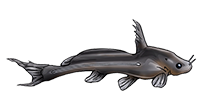Article © Chris Ralph, uploaded January 01, 2002.
My first thoughts on this subject were to mention some of the catfish that I keep along with my two pet Oscars in my tropical pond, but then I stopped to think for a while and decided that it would be best to mention some species of catfish which are better suited to say a 72" x 24" x 24" aquarium. In other words those species, which do not exceed 300mm to 450mm (12" to 18") in length. For those of you that are interested I personally keep quite a large number of South American Doradids with my Oscars including Pseudodoras niger and Pterodoras granulosus, which would easily outgrow a 72" aquarium. I do however, keep some smaller species of catfish in with the Oscars and I will mention some of these in this article.
Oscars or Astronotus ocellatus can attain a length of 280mm s.l. (standard length i.e. from the tip of the snout to the base of the caudal peduncle) or just over 11" for those of you that are not converted to metric. Oscars are native to South America and can be found in the Amazon and some of its tributaries, although most of the Oscars offered for sale tend to be captive-bred specimens. These fish can tolerate a wide range of water conditions, which opens up the options for keeping different catfishes with them. Oscars will accept both soft and hard water the criteria being that it is clean and well maintained with a temperature in the range of 79 to 86 ºF (26 to 30ºC). Oscars tend to be messy feeders and also have a fascination with moving their aquarium decor and substrate around, which rather tends to eliminate under gravel filters from the set up. Whilst you could use aquarium gravel as a substrate, I would personally recommend the use of aquarium sand especially as I am specifically talking about keeping catfish with the Oscars. I would also recommend the use of suitably sized external canister filtration and/or the use of a suitable number of internal power filters, along with some form of good aeration.
There are of course other species of larger cichlids, which you may be considering or indeed are keeping such as Theraps synspilum, which can attain a length of 300mm (12") s.l. or Severums or Heros severus which can attain a length of 180mm(7.5"). The list of cichlids is endless and the species kept will no doubt depend upon what appeals to you.
Anyway on to the catfish. Once again there is a list of catfish as long as your arm and no doubt someone will quite rightly point out that I could have included numerous species, but for the purpose of this article I have chosen the following species:
- Pimelodus maculatus or Spotted Pim
- Glyptoperichthys gibbiceps or Sailfin Pleco
- Megalodoras urunoscopus (formerly Megalodoras irwini) or Mother of Snails Catfish
- Hemisynodontis membranaceus or Moustache Catfish
- Parauchenoglanis macrostoma or Dwarf Giraffe Catfish
- Synodontis decorus or Clown Catfish
The catfish listed above are all species that I have known either from my own experience or from other fish keepers to be compatible with large cichlids including our dear friend the Oscar. I have chosen some catfish which originate from South America and some which originate from Africa. Each of the above species in this article is listed in the Planet Catfish "Cat-eLog" with further links from there.
Perhaps one important consideration to make before deciding to keep some of the larger cichlids is to first choose the species that you are interested in, and to then decide upon whether you intend to purchase small or large specimens, as this will then impact on the size of catfish that you ideally need to purchase. This in turn may also be a deciding factor when costs are taken into consideration. In an ideal world I prefer to purchase my fish as young specimens and enjoy watching them grow, but in some cases this is not always possible due to availability of stock etc. I have also been in the situation where half-grown specimens have been offered as they have outgrown their existing accommodation, and are in need of a good home. Unfortunately not everyone can accommodate or in some cases afford large aquariums, which is why I have deliberately chosen a 72" x 24" x 24" aquarium as the ideal size to accommodate some of the above mentioned fish. I am not recommending that all the above catfish be kept together, although from experience any combination of those mentioned would live quite happily together with cichlids. Getting back to the initial purchase of your stock, if you decide to keep small specimens of cichlids then you will most likely be able to keep similar sized catfish with them and have the added pleasure of watching them all grow up together. This could also mean that initially you could keep your fish in say a 48" x 18" x 18" aquarium with a view to ultimately accommodating the fish in a 72" x 24" x 24" aquarium. I guess there are a number of different options available, which depend upon each individual's circumstances at the time.
One important thing to remember is that these fish require sufficient space in order to grow, and believe me that is one thing that they do not have much problem with. I wish you well with your choice of catfish to keep with large cichlids.
Back to Shane's World index.




